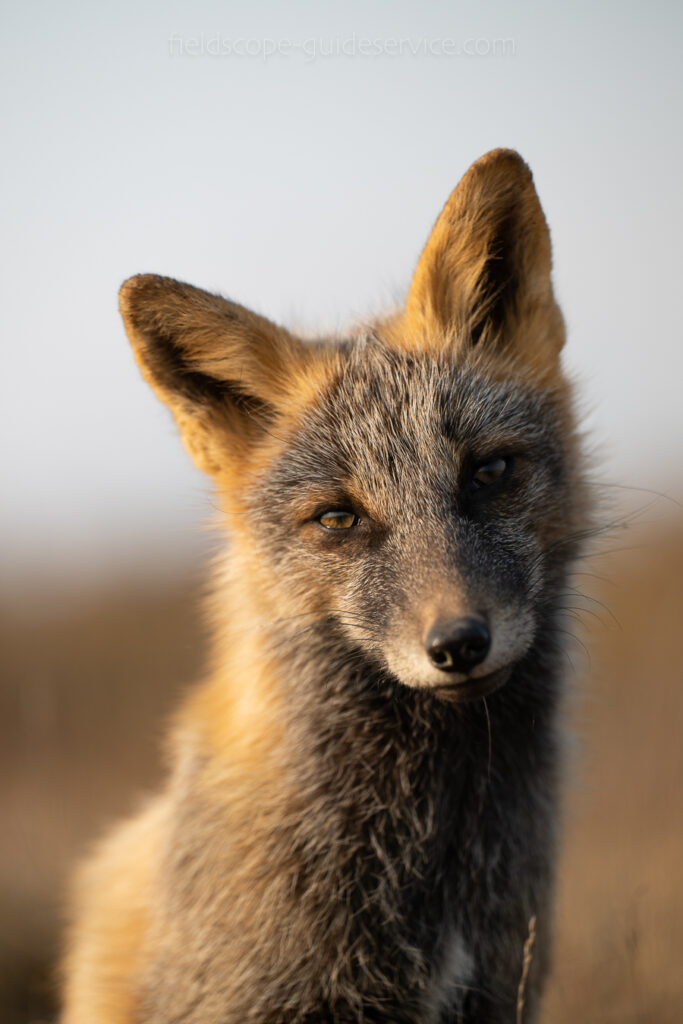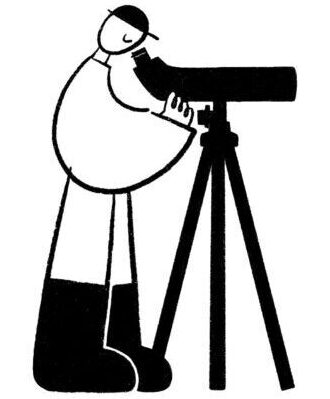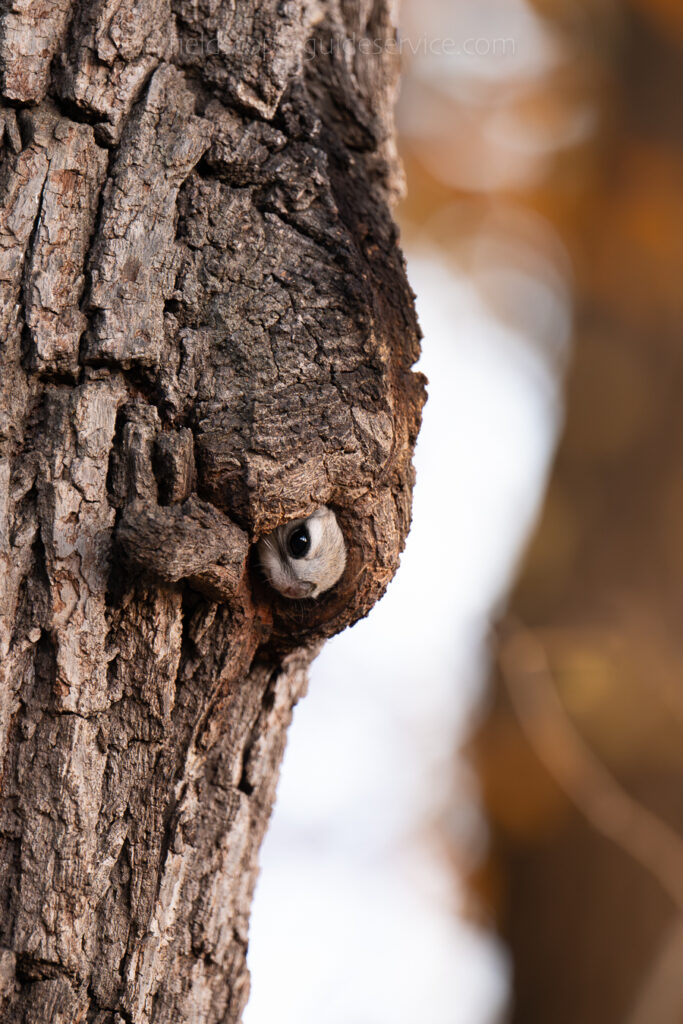
秋が深まり、エゾモモンガを取り巻く環境にも変化が起きています。
冬が終わって、イトウやアメマス、ニジマス、ブラウントラウトなど魚釣りに夢中になって、そしてまた夏の終わりからゲストと共にエゾモモンガの撮影が始まりました。
モモンガの赤ちゃんと出会ったり、夏には色々ありましたが、やっぱり少し暗いのが通常。それが9月になるとアレ?という時間帯に出てくれたりして10月には集団生活を始める巣穴もあるようで、日没後15分で出巣することも。
藪蚊が減り、寒すぎず、紅葉が美しい、10月と11月は今後エゾモモンガ撮影の穴場的な季節になりそうです。
As autumn deepens, the world around the Ezo flying squirrels is quietly changing.
After the long winter ended, I spent my days chasing fish like taimen, white-spotted char, rainbow trout, and brown trout. Then, as summer faded, the flying squirrel season began again—this time with many wonderful guests joining me in the forest.
There were some special moments, like meeting baby squirrels during the warm months.
In summer, they usually stay hidden until it’s quite dark, but by September, things start to shift—you might spot them earlier than expected. By October, some nests even become shared homes, and the squirrels start coming out just 15 minutes after sunset.
With fewer mosquitoes, comfortable cool air, and stunning autumn colors, I feel that October and November might become the hidden gems for photographing Ezo flying squirrels in the seasons ahead.
あれだけ冬に使っていた巣穴をなぜ夏になると使わなくなるのか、雨が流れ込む、虫が入る、樹液が出る、このあたりの理由が多いのかなと思う。その中で雨が入るというのは特に致命的でどんな生き物でもねぐらが濡れるというのは当然嫌がる。
そこで無数にある巣穴の中から、雨が入らない場所はどこだろう・・・と考えて確認したのが上の写真の巣穴でした。この時期には珍しく、巣穴の周りにはフレッシュな糞が落ちていて穴の淵の質感も良い。エゾモモンガの在宅を確信して、構図の検討に入ります。
巣穴の正面、数メートルにイタヤカエデが赤く紅葉して後ろにはカシワの大きな葉が黄色く色付いていました。
I’ve often wondered why Ezo flying squirrels stop using the nest holes they relied on so much during winter.
Maybe it’s because rain seeps in, insects get inside, or tree sap starts to flow—probably a mix of all those things. Among them, rainwater seems to be the most critical. No creature enjoys having its sleeping place soaked.
So, I started thinking: Which of these countless nest holes could stay dry, even in heavy rain?
That question led me to the nest shown in the photo above.
For this time of year, it was unusual to find fresh droppings scattered around the entrance, and the edges of the hole looked clean and well-used. That was enough to convince me that the squirrels were home. From there, I began to think about the best composition for the shot.
Right in front of the nest, just a few meters away, a maple tree (Itaya-kaede) was glowing bright red, while behind it, large oak leaves had turned a warm golden yellow. It was one of those perfect autumn scenes that make you forget the chill in the air.
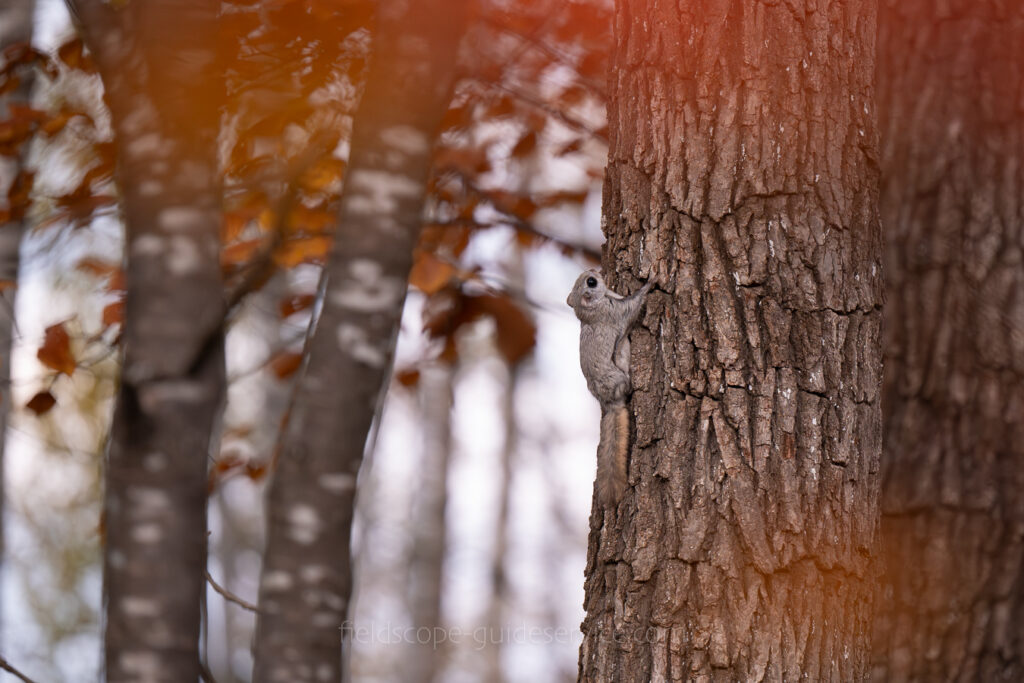
8メートル、5メートル、最後はブラインド布を被り3メートルまで、リサーチに時間を掛けて距離感を掴みます。
使用したレンズは70-200mmF2.8 、写真は若干クロップされていますが、200mmのレンズでも巣穴とモモンガを選べば撮影ができます。
秋は景色の変化が早くて、あっという間に葉っぱが染まり落ちていくので毎日違った写真になるのも面白いところ。初秋の鮮やかな紅葉から晩秋の渋い彩り、カラマツは遅れて染まるのでカラマツのある巣穴へ行けば黄色の絵が撮れます。
冬のモモンガも好きなのですが、秋って特別です。去っていく野鳥と落ちていく葉っぱ、静けさを増す自然に野生動物たちが際立ちます。その移り目の一瞬で生き物は来る冬に向けてざわざわしています。それは喜びの春とは違った、生きるための切実な手段のようです。
季節の移ろいと、その日の天候や光の具合、そして被写体である野生動物の行動。あらゆる可能性があり、観察に飽きることがありません。雨でも雪でも、辛抱強くフィールドに出続ければ他の人と少し違った姿に出会えるかもしれません。
I eased in to get the distance right — first at 8 meters, then 5 meters, and finally down to 3 meters with a blind cloth over me. I took my time on the research, feeling out the right spacing.
I used a 70–200mm F/2.8 lens. The image is slightly cropped, but even at 200mm you can frame the nest and the flying squirrel well if you pick the right hole and angle.
Autumn moves fast here — the colors change and the leaves fall in the blink of an eye — so every day can give you a different picture. From the vivid reds of early autumn to the more muted tones of late fall, there’s always something new. Larch (karamatsu) turns later than most, so if you head to a nest near larches you can capture a golden scene.
I love photographing flying squirrels in winter too, but autumn feels special. Migratory birds are leaving, leaves are dropping, and the woods grow quieter — wild animals stand out more against that hush. In that brief shifting moment the creatures are already restless, preparing for the coming winter. It’s not the joyous energy of spring, but a more urgent, survival-driven movement.
Seasonal change, the day’s weather and light, and the behavior of the wildlife — all of these create endless possibilities, so you never get tired of observing. Rain or snow, if you keep going out into the field with patience, you might catch behaviors and scenes that others miss.
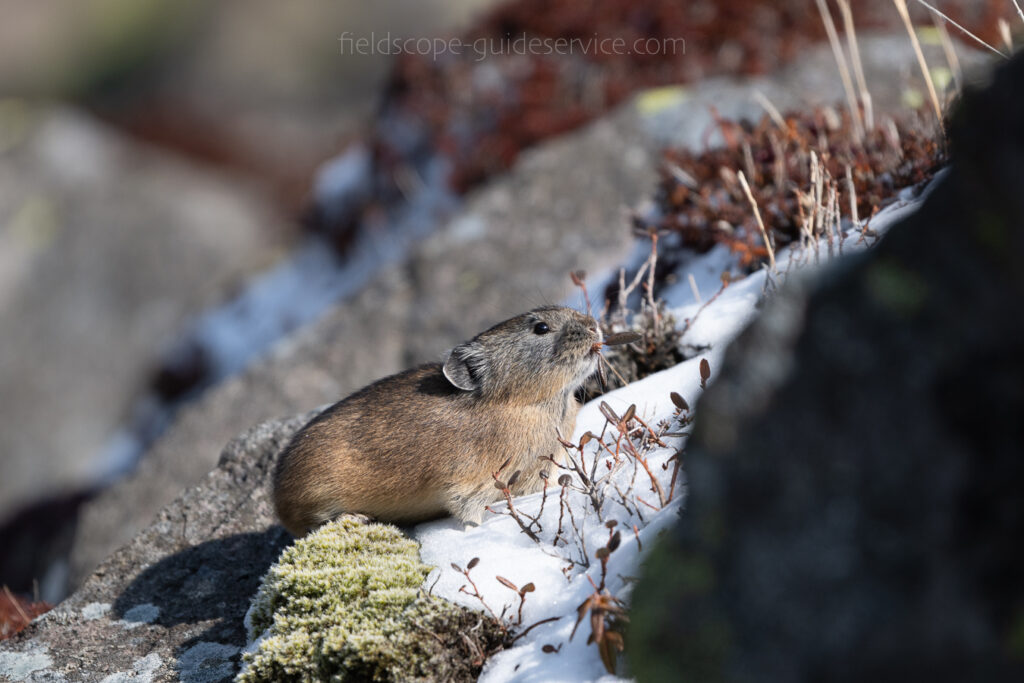
秋のガイドはナキウサギも外せません。
冬の準備に忙しく、雪が降っても陽が当たれば貯食に励んでいます。いい写真が撮れるのは光の柔らかい時間帯ですがエゾモモンガと時間が被ってしまうのが悩みどころ・・・でもやっぱり夕日や朝日に染まったナキウサギもいつか見てみたいです。
When it comes to autumn guiding, the pika is another highlight I can’t leave out.
They’re busy preparing for winter, and even after the first snow, they keep gathering food whenever the sun breaks through.
The best time for photos is when the light is soft — but that’s also when the Ezo flying squirrels become active, so it’s always a bit of a dilemma. Still, I can’t help but dream of the day I’ll see a pika glowing in the warm light of sunrise or sunset.
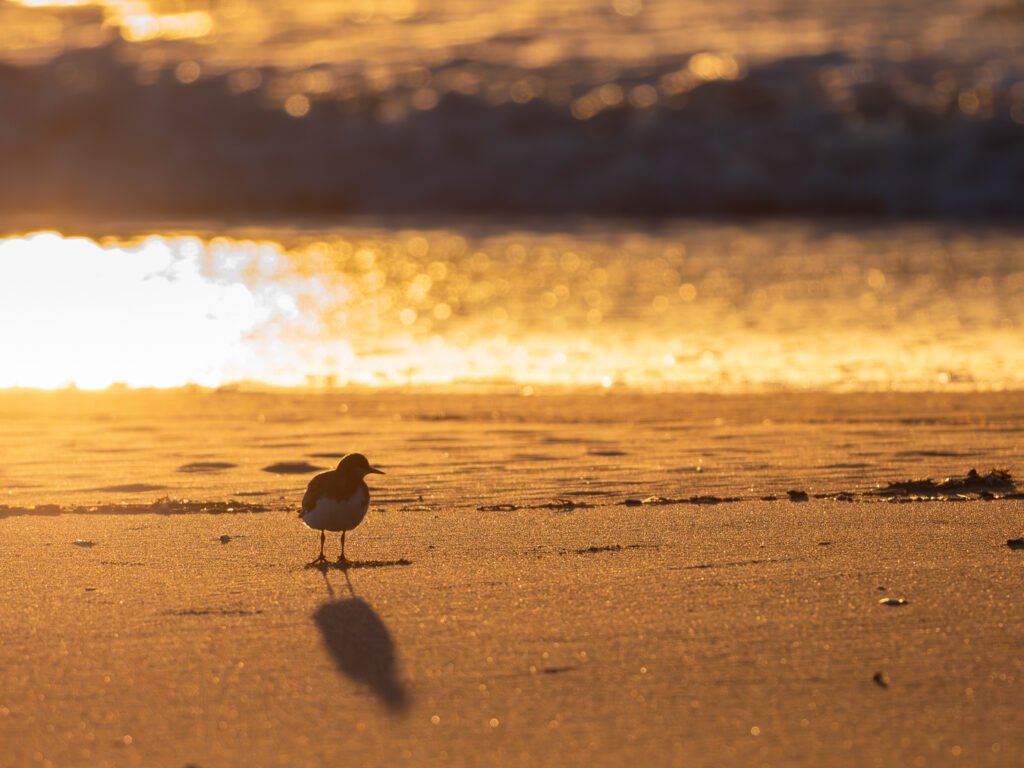
日が短くなってきて、午後2時を過ぎるころには光が柔らかくなり始めます。撮影には本当に良いことです。
これまで双眼鏡をメインに持ちガイドをしてきましたが、改めて写真を学び始めて技術的なサポートも今まで以上に可能になりました。今後もエキスパートなゲストの細かいリクエストにも応えられるようにしたいと考えています。
ターゲットとなる野生動物のどんな姿が撮影したいのか、シチュエーションや光の具合、ロケーションなど、撮りたい写真をイメージしているなら、ぜひ問い合わせの際にお知らせください。難易度が高いほど、長い準備とリサーチが必要なので、早いほど良いです。
すでにそういうリクエストをいただくゲストが何人か居ますが、1年前から相談をいただきます。面白い状況が起これば、こちらからメールをして急遽飛んでくる方もいます。この辺りがプライベートでガイドする強みだと考えています。
As the days grow shorter, the light starts to soften after around 2 p.m.—a wonderful thing for photography.
For many years I guided mainly with binoculars in hand, focusing on observation. But since I began studying photography more seriously, I’ve been able to offer much stronger technical support for my guests. My goal now is to meet even the detailed requests of expert photographers and help them capture the shots they truly envision.
If you already have a clear image of the kind of scene or behavior you’d like to photograph—the light, the setting, or a specific moment in the life of your target animal—please feel free to share it when you contact me. The more challenging the goal, the more time and research it takes to prepare, so the earlier I know, the better.
Some of my guests already reach out a year in advance to discuss their ideas. And sometimes, when an exciting situation unfolds in the field, I’ll send out a quick message—and a few of them hop on a plane right away. That’s the beauty of offering truly personal, private guiding.
